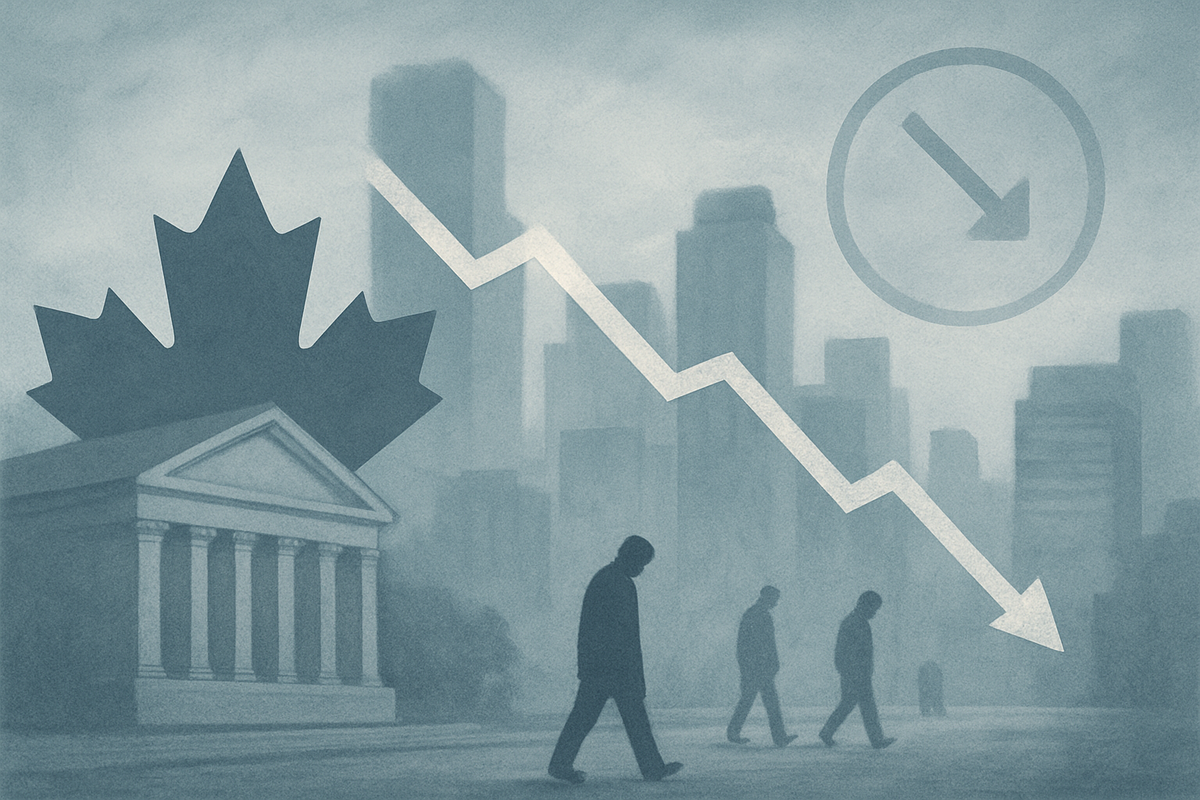
Ottawa, Canada – October 30, 2025 – Canada's labor market experienced a significant cooling in August 2025, with job vacancies plummeting to 457,400, their lowest level since August 2017. This stark decline, reported by Statistics Canada, represents a substantial 15.2% year-over-year decrease and signals a notable shift in the country's economic landscape. The immediate implications are profound, suggesting a weakening labor market that could compel the Bank of Canada to implement further interest rate cuts, potentially impacting the Canadian dollar and increasing financial strain on households.
This downturn in job availability coincided with a rise in the national unemployment rate to 7.1% in August, up from 6.9% in July and 6.7% in August 2024. This marks the highest unemployment rate since May 2016, excluding the unprecedented period of the pandemic. The increasing competition for a shrinking pool of jobs is evident in the climbing ratio of unemployed persons for every job vacancy, which reached 3.5 in August – a level not seen since November 2016 (outside of the pandemic's initial months).
A Deep Dive into Canada's Cooling Labor Market
Statistics Canada's August report painted a clear picture of a labor market in retreat. The 457,400 job vacancies represent a significant contraction, pushing the job vacancy rate down to 2.6% from 3.0% a year prior. This shift indicates a move away from a candidate-driven market, where employers vied for talent, towards one where job seekers face heightened competition for fewer open positions. Evidence of this increased difficulty for job seekers is stark: only 15.2% of unemployed Canadians in July 2025 found work the following month, a considerable drop from the 23.3% average for the same period between 2017 and 2019.
The timeline leading up to this point has seen several contributing factors. Beyond domestic economic shifts, economists have pointed to the lingering impact of tariffs imposed by the United States and broader global trade uncertainties as significant disruptors. Notably, Canadian export volumes experienced a sharp contraction in the second quarter of 2025, largely attributed to these tariffs, which in turn contributed to an overall contraction in the Canadian economy. Key players in this unfolding scenario include Statistics Canada, which provides the crucial data, and the Bank of Canada, whose monetary policy decisions are now under intense scrutiny. Initial market reactions have been swift, with financial markets increasing their expectations for a September interest rate cut by the Bank of Canada, seeing it as "almost certain," with further cuts anticipated before the year's end. This sentiment has also contributed to a weakening Canadian dollar, making it the weakest among G10 currencies.
Sector-specific declines in job vacancies were pronounced in transportation and warehousing, information and cultural industries, and retail and wholesale trade. Correspondingly, employment saw significant decreases in professional, scientific, and technical services, transportation and warehousing, and manufacturing. While some sectors, like agriculture, forestry, fishing and hunting, and construction, showed resilience or even growth in vacancies and payroll employment, the overall trend is one of widespread softening. Furthermore, the report highlighted growing underemployment, with nearly 9% of workers desiring more hours but unable to secure them, disproportionately affecting part-time employees. The statistic that 5.4% of Canadians held multiple jobs in August, often out of financial necessity, underscores the ongoing earnings challenges faced by many, even those who are employed. The pace of wage growth has also cooled, with average weekly earnings increasing by 3.0% year-over-year in August, following a 3.2% increase in July, and wages and salaries edging up a mere 0.2% in the second quarter—the lowest quarterly pace since 2016 (excluding the pandemic).
Corporate Fortunes Diverge Amidst Economic Shift
The significant recalibration of Canada's labor market, coupled with the anticipated monetary policy response from the Bank of Canada, is setting the stage for a notable divergence in corporate fortunes across various sectors. While some industries are poised to benefit from lower borrowing costs and a weaker Canadian dollar, others face mounting headwinds from reduced consumer spending and ongoing trade tensions.
Sectors sensitive to interest rates are likely to emerge as beneficiaries. The Real Estate sector, for instance, is expected to see a notable positive impact as lower mortgage rates improve affordability, potentially stimulating demand in a housing market that has been under pressure. Real Estate Investment Trusts (REITs), such as RioCan REIT (TSX:REI.UN) or Allied Properties REIT (TSX:AP.UN), could benefit from reduced financing costs for acquisitions and development, enhancing their attractiveness as defensive assets. Similarly, Financials, particularly major Canadian banks like Royal Bank of Canada (TSX:RY) and Toronto-Dominion Bank (TSX:TD), might experience increased loan demand from both businesses and consumers as borrowing becomes cheaper. While net interest margins could face some compression, higher loan volumes and overall banking activity, especially in corporate lending and mortgage refinancing, could bolster profitability. Defensive Utilities companies, known for their stable cash flows, are also expected to perform well in a low-rate environment as investors seek reliable dividends amidst economic uncertainty.
Conversely, a weaker Canadian dollar, a likely outcome of interest rate cuts, presents a significant advantage for export-oriented sectors. Manufacturing industries with strong export ties, particularly those supplying the robust U.S. market in areas like automotive components or forestry products, could see increased competitiveness and profitability. Similarly, Natural Resources companies, including those in Oil & Gas like Suncor Energy (TSX:SU) (NYSE: SU), Forestry firms such as West Fraser Timber (TSX:WFG) (NYSE: WFG), and Mining operations, which typically price their commodities in U.S. dollars, will see higher revenues when converting back to Canadian currency. The Tourism sector also stands to gain, as a more affordable Canadian dollar makes the country a more attractive destination for international visitors. Even Professional Services firms that export their expertise globally could see a boost. Major railway operators like Canadian National Railway (TSX:CNR) (NYSE: CNI), which facilitate significant export volumes, are well-positioned to benefit from both increased exports and potentially lower operational costs associated with a weaker loonie. Discount and essential retailers, such as Dollarama (TSX:DOL) or major grocery chains like Loblaw Companies (TSX:L), may also see continued resilience as consumers shift towards value-driven and essential purchases in a cautious economic climate.
On the losing side, the general Consumer Discretionary sector faces significant headwinds. Rising unemployment and a cautious consumer sentiment are likely to curb spending on non-essential goods and services. Retailers of items like clothing, electronics, and luxury goods, such as Aritzia (TSX:ATZ) or Canada Goose Holdings (TSX:GOOS) (NYSE: GOOS), could experience declining sales. The Travel and Entertainment industries, while potentially benefiting from a weaker dollar for inbound tourism, could suffer from reduced domestic spending on leisure activities. Labor-intensive sectors and those heavily reliant on domestic trade and investment are also vulnerable. Parts of Manufacturing already grappling with U.S. tariffs and global trade tensions continue to face challenges despite potential export boosts from a weaker currency. The Transportation sector, particularly trucking companies and those focused on domestic freight, may struggle with reduced freight volumes reflecting a general economic slowdown. Finally, businesses heavily reliant on imports will face increased costs due to a weaker Canadian dollar, potentially squeezing margins or leading to higher prices for consumers.
A Broader Economic Rebalancing and Policy Crossroads
The precipitous fall in Canadian job vacancies and the concurrent rise in unemployment in August 2025 are not isolated events but rather integral parts of a broader economic rebalancing. This shift signifies a departure from the overheated labor market conditions observed in the immediate post-pandemic era, moving towards a period of more pronounced economic slack and necessitating a critical policy response from the Bank of Canada.
This trend aligns with a general softening of the labor market that has been unfolding throughout 2024 and 2025. The data reveals significant sectoral disparities, with trade-exposed industries such as Manufacturing, Transportation and Warehousing, and Wholesale and Retail Trade bearing the brunt of job losses. This vulnerability is partly attributed to the renewed imposition of U.S. tariffs and persistent global trade uncertainties, which have dampened demand in these key sectors. While some areas like finance or utilities may show relative resilience, the overall hiring appetite has cooled across the economic spectrum. Moreover, the impact of demographic shifts and immigration is becoming increasingly apparent. While robust population growth has historically bolstered Canada's labor force, a slowdown since mid-2024, coupled with disproportionately high unemployment among youth (15-24) and recent immigrants, suggests that the pace of labor force growth has outstripped job creation capacity. Underlying these dynamics are ongoing challenges with stagnant labor productivity and the relentless march of technological shifts, including automation and Artificial Intelligence (AI), which continue to reshape job roles and demand new skill sets.
The ripple effects of this weakening labor market are extensive and could permeate various facets of the Canadian economy. Reduced consumer spending is an almost inevitable consequence of rising unemployment and slower wage growth, impacting retail and service industries. The housing market, already grappling with high household debt, faces further pressure as economic uncertainty and job insecurity deter potential buyers, particularly in the pre-construction condo segment. Businesses, facing heightened uncertainty, especially from trade tensions, are likely to scale back investment and hiring intentions, contributing to a contraction in overall business activity. On a societal level, increased unemployment places greater demands on social support programs and could lead to reduced tax revenues, straining government finances. Crucially, a persistent and significant rise in unemployment, coupled with other indicators like the contraction in Canada's GDP in Q2 2025, heightens the risk of an economic recession, a scenario economists have been debating for some time.
For the Bank of Canada, these labor market statistics present a clear policy imperative. Operating under a mandate to target 2% inflation while supporting maximum sustainable employment, the central bank would be strongly inclined to cut its key policy interest rate to stimulate the economy. Indeed, reports from late 2025 indicate the BoC has already undertaken several rate cuts in response to weakening economic conditions and trade uncertainties. The Bank's focus will be on monitoring underlying inflation measures to ensure that stimulative actions do not reignite price pressures, but the accumulating evidence of labor market slack would likely take precedence. The BoC would also utilize forward guidance to communicate its commitment to economic support, emphasizing its data-dependent approach. Historically, such movements in the Beveridge curve – where job vacancies fall and unemployment rises – have been characteristic of economic downturns, indicating increased slack in the labor market. Comparisons to historical periods, such as January 1976 when the unemployment rate also reached 7.1%, underscore the potential severity of the current situation and align with past Bank of Canada responses to cut rates during periods of economic weakness to encourage borrowing, spending, and investment.
Navigating the Path Ahead: A Cautious Outlook and Strategic Imperatives
The recent economic indicators, particularly the sharp drop in job vacancies and the rise in unemployment, coupled with the Bank of Canada's proactive interest rate cuts, set the stage for a period of cautious adjustment and strategic recalibration for the Canadian economy. The path ahead presents a mix of challenges and opportunities, demanding adaptability from businesses and continued vigilance from policymakers.
In the short term (late 2025 - 2026), Canada is largely expected to avoid a technical recession, though economic growth is forecasted to remain "lackluster" and below trend. Real GDP growth is projected to hover around 1.2-1.3% in 2025 and 1.1-1.7% in 2026. The unemployment rate is anticipated to average slightly above 7% for the next three quarters before gradually improving to approximately 6.6% by the end of 2026. Wage growth will likely remain subdued, and job losses could persist in trade-sensitive sectors, with youth unemployment remaining elevated. Core inflation is expected to move closer to the 2% target by 2026, aided by factors like the removal of the consumer portion of the carbon tax. While consumer spending may initially slow due to higher unemployment, lower interest rates and potential tax cuts could stimulate a rebound towards late 2026. Business investment, however, is expected to remain tepid given ongoing trade policy uncertainty, though residential investment may see a gradual recovery. The persistence of U.S. tariffs will continue to cast a shadow over Canadian exports.
Looking further out to the long term (2027 and beyond), GDP growth is projected to strengthen, potentially reaching 2.2% in 2027, contingent on stronger gains in labor productivity. The unemployment rate is forecast to trend around 6.3%. However, structural labor shortages are expected to persist in key sectors such as healthcare and construction, highlighting a perennial challenge for the Canadian economy. Addressing Canada's "structural productivity crisis" will be critical for sustainable long-term economic expansion. Demographic trends, including an aging population and continued reliance on immigration, will shape the workforce, necessitating targeted programs for youth and newcomers. The potential re-ratification of the USMCA agreement by mid-2026 could provide a significant boost to trade-related growth, though the broader landscape of U.S. trade policy may remain a source of enduring uncertainty.
For Canadian businesses, several strategic pivots will be essential. Trade diversification beyond the U.S. market, exploring avenues in Europe and Asia, and building supply chain resilience through increased domestic sourcing or strategic stockpiling, will be crucial in mitigating risks from volatile trade policies. Investing in technology adoption and innovation, particularly in areas like robotics, IoT, and AI, will be vital for enhancing efficiency and competitiveness across industries. With a softening labor market but persistent skill gaps, workforce development and adaptation through retraining programs and flexible policies to retain late-career workers will be key. Furthermore, rigorous operational efficiency and cost management, alongside a potential strategic focus on domestic and non-U.S. international demand, will help navigate the current economic headwinds.
Market opportunities will emerge from the stimulus provided by rate cuts, potentially boosting the housing market and making borrowing more attractive for investment, especially in burgeoning sectors like tech, healthcare, and green energy. Increased government spending, particularly on infrastructure, and a strengthening in consumer spending towards late 2026, also present avenues for growth. However, significant challenges remain, including persistent trade uncertainty, weak business investment, Canada's enduring productivity lag, and regional economic disparities. The most likely scenario is a soft landing with gradual recovery, where Canada avoids a deep recession but experiences a period of slow growth before a more robust rebound. However, risks of prolonged stagnation or even a recession cannot be entirely discounted if economic conditions materially underperform expectations or trade conflicts intensify.
The Road Ahead: Navigating Structural Shifts and Investor Vigilance
The significant decline in Canadian job vacancies and the corresponding rise in unemployment in August 2025 represent a critical juncture for the Canadian economy, signaling a shift from post-pandemic exuberance to a more challenging, structurally rebalancing environment. The Bank of Canada's aggressive monetary easing, while a necessary response, underscores the depth of the economic headwinds currently faced.
Key Takeaways: The most prominent takeaway is the undeniable deterioration of the Canadian labor market, marked by substantial job losses and a rising unemployment rate that reached its highest level since 2016. This broad-based softening, particularly acute in trade-sensitive sectors, prompted the Bank of Canada to implement a series of interest rate cuts, bringing its policy rate down to 2.25% by October 2025. Despite these stimulative measures, persistent economic weakness and excess capacity are projected to endure until at least 2027. The "structural damage" inflicted by ongoing trade uncertainty, especially with the U.S., has significantly impacted Canadian exports and business investment, potentially leading to a permanently lower growth trajectory. Furthermore, while population growth has been a key driver, an easing of immigration targets means fewer new jobs are needed, yet this also dampens consumption.
Market Assessment: Financial markets have largely priced in the Bank of Canada's dovish stance, but the outlook for Canadian equities and bonds remains nuanced. Rate-sensitive sectors like real estate and consumer finance may see some uplift from cheaper borrowing costs. Bondholders have already benefited from lower rates, enhancing the attractiveness of existing higher-yielding bonds. The Canadian dollar (CAD) has experienced depreciation against the U.S. dollar amidst global trade tensions and a slowing domestic economy, though some analysts foresee a potential rebound in 2026 if trade uncertainties subside. However, broader economic slack is likely to temper corporate earnings and pressure valuations across many sectors, necessitating a selective approach from investors.
Lasting Impact: The current slowdown is more than a mere cyclical downturn; it signals a potential structural transition for the Canadian economy. The "structural damage" from trade conflicts reduces productive capacity and adds costs, suggesting that monetary policy alone may struggle to boost demand while maintaining low inflation effectively. Prolonged unemployment can have profound and lasting effects, including skills depletion, reduced consumption, and long-term financial strain for individuals, potentially impacting future educational opportunities and contributing to increased societal pessimism. Businesses, faced with persistent uncertainty, have delayed crucial investments, which could further stifle productivity gains and future job creation, cementing a lower growth potential for the economy.
What Investors Should Watch For: Investors must remain highly vigilant, closely monitoring several key indicators. Labor market data, including the unemployment rate and wage growth, will provide crucial signals about the pace of economic recovery and guide future Bank of Canada decisions. Inflation trends are also vital; while the BoC has prioritized economic support, any significant uptick could limit further rate cuts, though current projections anticipate inflation remaining near the 2% target. A sustained recovery in business investment and exports, particularly in trade-sensitive sectors, will be indicative of a broader economic rebound. Consumer spending and confidence will also be critical barometers, as their sustained improvement is essential for overall economic health. Finally, the Bank of Canada's forward guidance will offer insights into its evolving sentiment, and global economic developments, particularly concerning U.S. trade policy, will continue to be significant external factors influencing Canada's trajectory.
While a period of cautious optimism exists regarding the avoidance of a hard recession, Canada's path to sustained and robust growth hinges on a significant stabilization of its labor market, a de-escalation of global trade tensions, and the effective transmission of current monetary policies into broader economic activity. The coming months will be pivotal in determining the long-term shape of the Canadian financial landscape.
This content is intended for informational purposes only and is not financial advice






